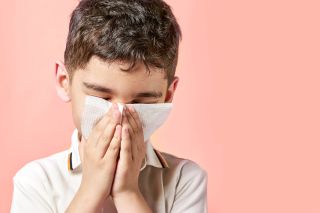Child Development
Why Are Food Allergies Becoming So Common?
Food allergies in children are on the rise. Here's why.
Updated April 7, 2024 Reviewed by Devon Frye
When I was a kid, I took a peanut butter and jelly sandwich to school almost every day. In fact, most of the kids in my class ate peanut butter and jelly weekly, if not daily for the entire duration of elementary school—it was our parents' go-to lunch for kids.
Anyone who has had kids more recently than the early 1980s knows that this isn’t the case anymore. Many schools are nut-free zones now, and others restrict the consumption of milk products and even eggs because so many children these days are allergic to these foods. Nut allergies in particular can be incredibly dangerous, so most schools and other public agencies just don’t want to take the risk of allowing nuts into their buildings.

An allergy is when your body treats a particular substance as an intruder, which makes your immune system release various chemicals that cause physical symptoms. Seasonal allergies just generally make you sneezy and sleepy (and grumpy, if we’re naming dwarfs). Pollen, grass, mold, and ragweed seem to be the biggest culprits.
But food allergies—the most common of which are to milk, eggs, nuts, wheat, soy, fish (especially shellfish), and sesame—can cause severe damage to the body and even result in death if not addressed quickly. In fact, 40 percent of children and more than half of adults with food allergies have experienced severe allergic reactions including anaphylaxis.
The reason some people have allergies and others don’t is mostly genetic—if one of your parents is allergic to something, it increases your odds of being allergic as well; if both parents are allergic, it increases your odds even more (Koplin et al., 2013). Eczema is another early risk factor: One study found that infants with eczema were 6 times more likely to have an egg allergy and 11 times more likely to have a peanut allergy than kids without (Martin et al., 2015).
Importantly, food allergies are indeed on the rise. According to the Centers for Disease Control and Prevention, food allergies in children have increased by a staggering 50 percent between 1997 and 2011, and within that range, allergies to nuts have more than tripled.
We don’t know for sure why this is happening, but there are a lot of theories. One is that we are living cleaner now than we were several decades ago—we use sanitizers, we protect ourselves from getting sick with more medications, and we live in cleaner, more animal-free spaces. This means that our bodies aren’t getting exposed to as many contaminants as we used to, which isn’t giving our immune system the experience it needs to tell when something is an actual contaminant.
Another hypothesis is that kids spend less time outside, in the sun, than they used to, and as a result, they aren’t getting enough Vitamin D. Vitamin D deficiency has indeed been linked to food allergies.
But the hypothesis that (in my opinion) makes the most sense is that doctors used to recommend that parents delay the introduction of common allergens like eggs and nuts in infants as a way to prevent allergies. In some cases, it was even recommended that mothers avoid common allergens while pregnant or breastfeeding to avoid passing on allergies to their newborns (Grimshaw et al., 2017).
Yet more recent studies have shown that delaying exposure to common allergens might make developing a food allergy more likely. One study reported that infants who were introduced to eggs between 10 to 12 months or later were significantly more likely to develop an egg allergy when compared to infants who were introduced to eggs at 4 to 6 months (Koplin et al., 2010).
Likewise, in another study that randomly assigned 640 infants who were at risk for the development of a peanut allergy (either because they had severe eczema or an egg allergy) to either gain exposure to peanuts between 4 and 11 months of age or to avoid peanuts completely until age 5. The results were staggering: While 13.7 percent of the infants who avoided peanuts ended up with a peanut allergy, only 1.9 percent of the infants who were exposed to peanuts early in infancy became allergic to peanuts (Du Toit et al., 2015). Many other studies have now echoed these findings.
The moral of this story is that being exposed to various common allergens might help teach the body which substances are safe, and which are dangerous. And as a result of this new work, the American Academy of Allergy, Asthma, and Immunology now recommends early exposure to common allergens, and that new foods be introduced at a rate of one new food every three to five days in an age-appropriate manner. Trying new foods can also help prevent picky eating behaviors. And exposure to relatively safe contaminants might help “exercise” the immune system so that it can grow to be stronger.
Indeed, several studies have now reported that infants who are exposed to contaminants by having contact with older siblings or owning a pet dog are less likely to develop food allergies (e.g., Koplin et al., 2012). So maybe letting your kids get a little dirty once in a while and trying out new things whenever possible (and safe) will not only help our kids grow up to be braver, more confident adults, but also help their immune systems be more effective as well, keeping children’s bodies and minds healthier and happier for it.
References
Du Toit, G., Roberts, G., Sayre, P. H., Bahnson, H. T., Radulovic, S., Santos, A. F., ... & Lack, G. (2015). Randomized trial of peanut consumption in infants at risk for peanut allergy. New England Journal of Medicine, 372(9), 803-813.
Grimshaw, K., Logan, K., O'Donovan, S., Kiely, M., Patient, K., Van Bilsen, J., ... & Roberts, G. (2017). Modifying the infant's diet to prevent food allergy. Archives of disease in childhood, 102(2), 179-186.
Koplin, J. J., Allen, K. J., Gurrin, L. C., Peters, R. L., Lowe, A. J., Tang, M. L., ... & HealthNuts Study Team. (2013). The impact of family history of allergy on risk of food allergy: a population-based study of infants. International journal of environmental research and public health, 10(11), 5364-5377.
Koplin, J. J., Dharmage, S. C., Ponsonby, A. L., Tang, M. L. K., Lowe, A. J., Gurrin, L. C., ... & HealthNuts Investigators. (2012). Environmental and demographic risk factors for egg allergy in a population‐based study of infants. Allergy, 67(11), 1415-1422.
Koplin, J. J., Osborne, N. J., Wake, M., Martin, P. E., Gurrin, L. C., Robinson, M. N., ... & Allen, K. J. (2010). Can early introduction of egg prevent egg allergy in infants? A population-based study. Journal of Allergy and Clinical Immunology, 126(4), 807-813.
Martin, P. E., Eckert, J. K., Koplin, J. J., Lowe, A. J., Gurrin, L. C., Dharmage, S. C., ... & HealthNuts Study Investigators. (2015). Which infants with eczema are at risk of food allergy? Results from a population‐based cohort. Clinical & Experimental Allergy, 45(1), 255-264.




